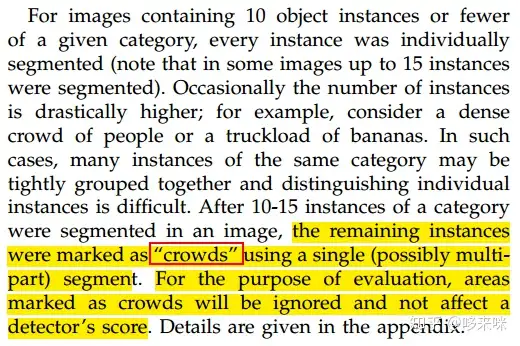引用源:https://zhuanlan.zhihu.com/p/110676412
检测指标通常用AP来衡量,现有的多个评测代码,比如COCO、VOC、Wider Face等等,AP的计算原理都是一样的,https://github.com/huangh12/Object-Detection-Metrics即逼近PR曲线下的面积,因此从PR曲线到AP的计算大同小异。关键的差异在于PR曲线的获取上,各家的思路会有些差异,这个关键就反映在det与gt的match策略上。
在COCO中,gt还有一个crowd的属性,之前一直认为crowd就代表ignore,但是仔细看代码会发现,这个crowd属性和ignore其实是不同的,ignore是gt的另一个属性,
在计算AP的时候两者的处理方式不同,因此要格外注意。
各家评测系统的核心差异,主要就反映在det与gt的match策略上。 COCO的匹配思想主要体现在下面一段代码中:
首先,det按照得分降序排列, gt按照是否ignore(0表示否1,表示是)升序排列,也就是把ignore为1的gt扔到到后面去。
其匹配思想可以概括为:
- 首先,得分优先原则,即得分大的det先去匹配gt;
- 每次匹配的时候,每次匹配时的gt candidates是未被匹配的gt并上已匹配但是属性crowd为true的gt;
- 从前到后遍历gt,从gt candidates中选择与当前det的iou最大的(需满足前提,即大于iou thresh)作为best match。
- 匹配过程中若已经完成了一次常规匹配(reg match,也即det匹配到了一个非ignore的gt,注意这里只说了非ignore,并没有说非crowd),而且遍历到了gt的ignore=1部分,那么就趁早break,结束此det的match过程了。
- 每次匹配过程结束(每次匹配过程就是一个det去找gt的过程),记录该det匹配到的gt的id(dtm),记录gt匹配到det的id(gtm),以及det的ignore情况(dtIg,即该det匹配到的gt的ignore属性)。
def evaluateImg(self, imgId, catId, aRng, maxDet):
'''
perform evaluation for single category and image
:return: dict (single image results)
'''
p = self.params
if p.useCats:
gt = self._gts[imgId,catId]
dt = self._dts[imgId,catId]
else:
gt = [_ for cId in p.catIds for _ in self._gts[imgId,cId]]
dt = [_ for cId in p.catIds for _ in self._dts[imgId,cId]]
if len(gt) == 0 and len(dt) ==0:
return None
for g in gt:
if g['ignore'] or (g['area']<aRng[0] or g['area']>aRng[1]):
g['_ignore'] = 1
else:
g['_ignore'] = 0
# sort dt highest score first, sort gt ignore last
gtind = np.argsort([g['_ignore'] for g in gt], kind='mergesort')
gt = [gt[i] for i in gtind]
dtind = np.argsort([-d['score'] for d in dt], kind='mergesort')
dt = [dt[i] for i in dtind[0:maxDet]]
iscrowd = [int(o['iscrowd']) for o in gt]
# load computed ious
ious = self.ious[imgId, catId][:, gtind] if len(self.ious[imgId, catId]) > 0 else self.ious[imgId, catId]
T = len(p.iouThrs)
G = len(gt)
D = len(dt)
gtm = np.zeros((T,G))
dtm = np.zeros((T,D))
gtIg = np.array([g['_ignore'] for g in gt])
dtIg = np.zeros((T,D))
if not len(ious)==0:
for tind, t in enumerate(p.iouThrs):
for dind, d in enumerate(dt):
# information about best match so far (m=-1 -> unmatched)
iou = min([t,1-1e-10])
m = -1
for gind, g in enumerate(gt):
# if this gt already matched, and not a crowd, continue
if gtm[tind,gind]>0 and not iscrowd[gind]:
continue
# if dt matched to reg gt, and on ignore gt, stop
if m>-1 and gtIg[m]==0 and gtIg[gind]==1:
break
# continue to next gt unless better match made
if ious[dind,gind] < iou:
continue
# if match successful and best so far, store appropriately
iou=ious[dind,gind]
m=gind
# if match made store id of match for both dt and gt
if m ==-1:
continue
dtIg[tind,dind] = gtIg[m]
dtm[tind,dind] = gt[m]['id']
gtm[tind,m] = d['id']
# set unmatched detections outside of area range to ignore
a = np.array([d['area']<aRng[0] or d['area']>aRng[1] for d in dt]).reshape((1, len(dt)))
dtIg = np.logical_or(dtIg, np.logical_and(dtm==0, np.repeat(a,T,0)))
# store results for given image and category
return {
'image_id': imgId,
'category_id': catId,
'aRng': aRng,
'maxDet': maxDet,
'dtIds': [d['id'] for d in dt],
'gtIds': [g['id'] for g in gt],
'dtMatches': dtm,
'gtMatches': gtm,
'dtScores': [d['score'] for d in dt],
'gtIgnore': gtIg,
'dtIgnore': dtIg,
}COCO的匹配过程可以说是很细致了。从上面的匹配过程可以发现,评测时绝对不允许多个det匹配到同一个crowd为False的gt上(代码如下),但是却允许多个det匹配到crowd为True的gt上。
# if this gt already matched, and not a crowd, continue
if gtm[tind,gind]>0 and not iscrowd[gind]:
continue之所以对crowd为True的gt网开一面,看一下MSCOCO的原始论文中关于crowd的定义就明白了。
简言之,就是crowd的物体确实是有一堆密集的东西在一起(比如一卡车香蕉),标注比较困难,所以就用crowd来减轻负担了。

在cocoeval.py中set ignore flag的时候,ignore flag完全由crowd属性决定。
# set ignore flag
for gt in gts:
gt['ignore'] = gt['ignore'] if 'ignore' in gt else 0
gt['ignore'] = 'iscrowd' in gt and gt['iscrowd']而ignore为True的gt样本在最后计算AP的时候没有起作用,所以crowd为True的gt确实没有影响到最后的AP。
COCO的评测代码为GT设计的crowd属性非常合理,考虑很细致,令人佩服。
继续回到刚才的匹配过程的代码,刚才说到了匹配时允许多个det匹配到crowd为True的gt上。但是,对于ignore为True的gt,却并没有说是否允许多个det匹配上去。
而这种设计是合理的!
因为,ignore属性在本质上其用途是为了在计算AP的时候不考虑这些gt,而crowd为True的gt是因为密集物体聚集(所以允许多个det匹配上去)。
ignore只是为了在计算AP的时候屏蔽掉某些gt,比如对想要检测的gt设置了area range时候,那么我们只需要将gt的ignore属性重新赋值就可以了(将area range之外的gt ignore设成True)。
此前,为了去掉crowd为True的gt对AP的影响,所以crowd为True的gt都被设成了ignore为True。
crowd属性与ignore属性,其含义与用途,其实已经反映在他们的名字上了。
那什么时候ignore的gt才允许多个det匹配上去呢? 这个,完全取决于这个gt是否crowd为True,与ignore的取值无关。
例如,对于一个ignore为True,crowd为False的gt,匹配过程最多只允许一个det匹配上去,0个或者1个det匹配都不影响最终的AP,
但是如果有大量的det都检测的该gt,那么AP上就会有punishment,因为这些多余的det只能匹配到其他gt上,相当于false positive了。
而对于一个ignore为True,crowd为True的gt,匹配过程允许无数个det匹配上去,而且不影响最终的AP计算。
因此,需要摒弃之前所认为的crowd等同于ignore的思维旧势。
crowd是region级别的,而ignore是instance级别的,一个严谨的检测标注规范应该独立标注二者,crowd用来表示密集聚集的一个区域,用ignore来忽略类标不明的一个instance个体。
但是,在目前的实际业务中,只有ignore属性的标注,而且ignore属性事实上在业务中被当作crowd在用。
VOC和Wider Face也没有设置crowd属性,在计算AP的时候,直接把ignore当作crowd在用。而且匹配过程和COCO也不一样。
VOC以及Wider Face的匹配都是把det匹配到iou最大的一个gt上,这个匹配过程简单得就好像没有匹配过程一样。
